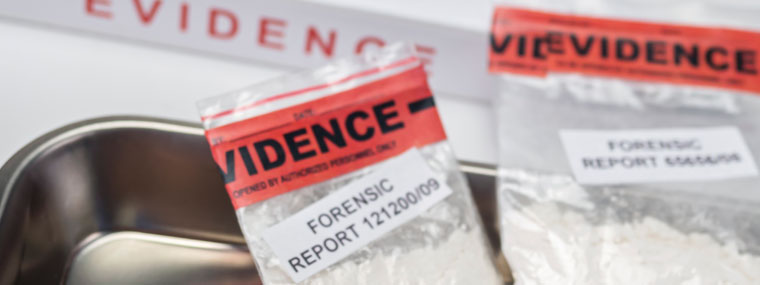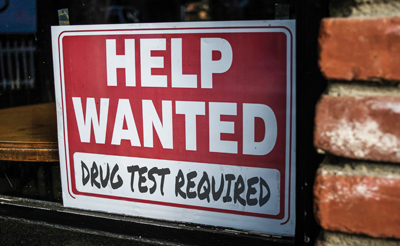
Drug Testing Policies and Procedures
By Diane M. Calabrese / Published July 2023

Test everyone or test no one. That’s the short of it when implementing a drug-testing policy not mandated by federal or state law.
Drug testing is mandated for holders of commercial driver’s licenses (CDLs) by the U.S. Department of Transportation (DOT), but employers need not get involved in the testing. They must simply ensure that their employees who drive commercial vehicles have CDLs.
In fact, in many instances requiring employees to have a CDL may be simpler than developing policies and procedures for drug testing. Of course, for employees who never drive a commercial vehicle, the approach doesn’t work.
The “test everyone or test no one” approach gets to the need to apply employee policies uniformly. In certain instances, OSHA [Occupational Safety and Health Administration] allows drug testing of individuals involved in reportable workplace incidents.
In most cases, though, if individuals are suspected of drug use because of their comportment, singling them out for testing still may prove to be risky for the employer. If their demeanor has changed because of something other than drug use, such as a medical condition, the employer could be set up for a claim of discrimination.
At the same time, even if a drug test reveals drug use, the information may be useless. The employee could be taking prescription medication that will result in a positive drug test and void any conclusion about errant drug use.
To avoid confusion about testing, applicable policies must be written and coupled with documentation of procedures. All laws—state and local—must be followed. Some states restrict random drug testing, for instance, and some states prohibit it.
With “recreational” use of cannabis being legalized in many states, employers have a new cause for concern. Cannabis impairs one’s mental state just as other drugs and alcohol do.
Drug-testing policies and procedures is an area that probably deserves more attention from professional associations. Testing is in theory part of doing business, and identification of best practices would help the industry.
“Our policy is for drug testing at the time of hire only,” says Mike Gruver, general manager at Hydrus Detergents in Estherville, IA. “It was a general HR consultant who advised the use of it as a policy for new hires.”
Distinguishing between medicinal and recreational drug use when testing is a challenge. “How do you test for and write your policy to protect the safety of all employees and not violate labor laws?” asks Gruver.
“We are looking at policies other companies are using to evaluate a best practice,” explains Gruver. He adds that manufacturers must stay up to date on human resource policies in a way that will “reflect the times.”
Members of our industry may not want to believe that drugs could create a problem in the workplace, yet the possibility is real.
The CDL Route
Passed in 1991, the Omnibus Transportation Employee Testing Act requires agencies under DOT [Department of Transportation] to implement drug and alcohol testing for employees in positions that are “safety sensitive.” The details of the resulting mandate can be found in 49CFR Part 40—Procedures for Transportation Drug and Alcohol Testing Program (https://www.ecfr.gov/current/title-49/subtitle-A/part-40).
Called Part 40 for short, there is nothing abbreviated about the details in the procedures. If printed out, Part 40 would run to 98 pages.
Part 40 covers everything from the training of urine collection personnel to threshold levels of indicators found. Any business thinking of implementing a drug-testing policy may want to first peruse the 98 pages that apply to DOT entities. Doing so will offer a quick immersion in just how complicated things can get for a business.
An employee may refuse testing, challenge testing, try to substitute samples, or not provide a sufficient sample. Sample custody is another issue. The days of asking for a urine sample and sending it off to a lab are largely gone.
Employees will probably have to go to a third-party site to be tested. Excluding on-site involvement elevates the perceived objectivity of the tests among employees. It also should guarantee more accurate results.
Even if a positive test is returned, that’s just the beginning of a two-step (at minimum) process. A second test will be needed to validate if the employee does not accept the results.
Hospitals have long been places where random testing of employees was done, and employees were advised of it as a condition of employment. Now, because of the difficulty of carrying out such testing without violating employee rights under federal law, many hospitals have just abandoned the testing.
The glossary of drug-testing terminology at the beginning of Part 40 is another useful reference for business owners who want to learn more about parameters. Note that whether it is “safety-sensitive” testing or not, anyone who tests positive may not simply be jettisoned from employment.
Rehabilitation followed by a retest may be the expected outcome for some who test positive. Whichever path is taken, Part 40 puts strict privacy protections in place for employees.
Requiring employees to have a CDL, if it might be needed at some point, may be a viable alternative to developing in-house policies and procedures for drug testing. The Federal Motor Carrier Safety Administration (FMCSA) under DOT administers the CDL program under Part 40. FMCSA mandates drug and alcohol supervisor training (120 minutes online) for anyone who operates a vehicle that requires a CDL and supervises others who operate vehicles that require a CDL. The requirement may apply to some members of our industry. Do a quick check on the requirement by going through the online question tree “Am I covered?” at https://www.transportation.gov/odapc/am-i-covered.
Assistance
SAMHSA [Substance Abuse and Mental Health Services Administration], which is part of the U.S. Department of Health and Human Services (HHS), is an excellent starting point for developing or refining drug testing policies and procedures.
Prevention and deterrence are parts of a drug-free workplace program, according to SAMHSA. Any program designed to prevent or deter must comply with all laws at the federal, state, and local levels.
Here are resources available free at the SAMSHA.gov website: lists of certified testing laboratories, manuals and handbooks on collecting oral and urine samples, and medical review officer (MRO) guidance and case studies. MROs validate and weigh in on questions about accuracy.
The essentials of an in-house testing program begin with the who, what, when, where, why, and how questions. Make a list of them, and consider the implications of the answers.
Who is being tested and why? When will the testing be done? How will the testing be done? Who will conduct the tests? Where will tests be conducted? Who pays for testing? What parameters are used to ensure accuracy of tests? And the biggest question of all: What are the legal rights of an employee who tests positive?
Although testing is all about prevention and deterrence, it can cause a lot of problems for an employer and yet not prevent or deter drug use. If an employee challenges results or removal from employment, the employer will incur the cost of resolving the dispute.
Test samples may include urine, saliva, hair, and perspiration. Urine is the most common type of sample.
Results of tests are protected information, and an employer who requires a test must also ensure confidentiality. (A breach in confidentiality can cause problems for an employer, even though he or she is not responsible for the lapse.)
SAMHSA recognizes six categories of drug tests: pre-employment, annual physical, for-cause, post- accident, post-treatment, and random. Regard-less of category, make certain tests apply to all employees in the same way. The individual must be informed that testing is being done—there must be absolutely no surreptitious efforts.
Although SAMHSA cites random tests as the most useful as a deterrent to illicit drug use, such tests can create the most problems for an employer. (And in some states, random testing is not legal.)
A drug-free employee who is selected for a random test may perceive the selection as a form of harassment, for example. If doing random tests, have a written description of how the randomness of selection has been guaranteed.
The safest route for an employer who wants to test is to make a negative test a condition of employment and test every individual who is offered a job.
Will drug testing cause an employer to lose prospective employees? It might. Some potential hires may see the testing requirement as an indicator that the employer does not trust them and then choose another job opportunity.
Before going too far in developing drug policies and procedures, be sure to check relevant laws for the state (or states) in which a company operates. Be sure to conform with them as well as with any local laws.
Federal law, except in the case of “safety-sensitive” (Part 40) testing under DOT, does not offer much guidance on how to develop a testing method that protects employees and the employer (perhaps because it’s difficult).
However, many federal laws will come into play to push back on the employer if the employee perceives that testing was done in a punitive or discriminatory way.






